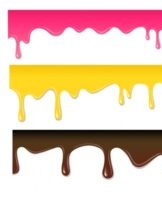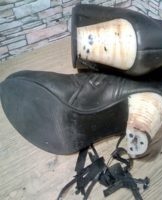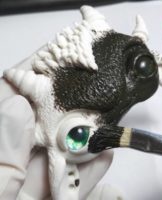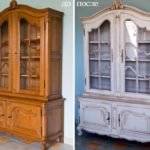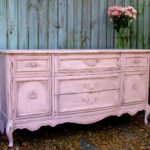Step-by-step DIY instructions for painting old furniture in a different color
In interior design, designers often use old, restored furniture as an accent. Wooden cupboards, cupboards and coats are processed after painting. Using a special technique, they are given an artistic antiquity that fits perfectly into the Provencal and shabby chic style. You can make a design object yourself from old furniture, using paint and varnish materials left over after repair for painting.
What furniture can be repainted
Thanks to modern paints and varnishes, all furnishings and garden furniture are subject to renewal:
- in wood;
- metal;
- Plastic;
- pressed sawdust;
- varnished;
- laminated.
You can repaint modern and Soviet furniture. Laminate and varnish are completely removed using a circular nozzle grinder. Smooth surfaces only need sandpaper to make them rough.
What you need to work
An approximate list of materials and tools:
| Inventory | The description |
| Dye | In cans or aerosols |
| Varnish | Glossy, matte or semi-matte |
| Putty, primer | On the same basis as painting |
| Sandpaper | coarse and fine grain |
| Plastic tray | For painting |
| Brush | With synthetic bristles, for painting on small parts |
| Roll | Short pile, for large areas |
| Small rubber spatula | To distribute the filler |
| Screwdriver | For dismantling prefabricated elements - table, sofa, wardrobe |
| masking tape | Glue on non-removable fittings |
| Newspapers, plastic wrap | Place under the product |
You will also need protective gloves and goggles for the job if the paints and varnishes give off a pungent odor.
Preparatory work
In order for the coating to be smooth, the surface must be properly prepared for painting.
Visual inspection
Before work, the condition of the furniture is assessed. Old chairs, sofas and armchairs often need reupholstering. Loose feet and squeaky doors should also be fixed before painting.
Remove the old coating
In addition to emery and grinder scraper, lacquer is removed from furniture using solvents or heated with a construction hair dryer, and then cleaned. But the easiest way to roughen a smooth surface is to sand with emery.
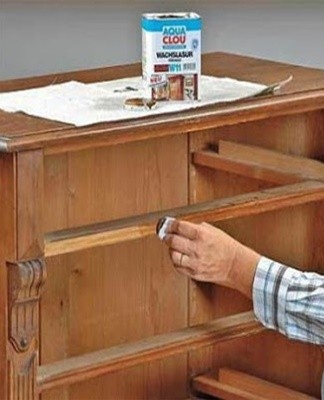
Sanding
Wooden furniture is cleaned along the grain lines. For better adhesion, the metal surface is degreased with acetone, alcohol or white spirit.
Filling and priming
Deep cracks, chips and scratches that could not be smoothed out with emery are covered with putty. For a durable coating, latex compounds are used that form elastic bonds. As a result, the paint will not crack due to temperature drops.
Before applying the primer, the areas with the filler are sanded again.Surfaces coated with a water-based primer should not be cleaned with a damp cloth before painting.
What can be repainted
You can update the look of old furniture with paint, stain primer, or varnish.
Primer
To paint wooden furniture, you need a special primer. The coating provides reliable adhesion of paint to the surface and has an antiseptic property. Compositions of a similar shade and manufacturer are in optimal contact with each other. Due to the difference between the binder components of primer and paint from different companies, the strength of the coating decreases.
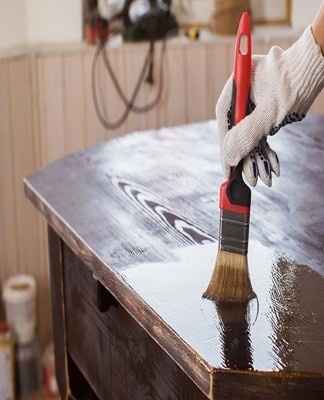
Water-based flooring will not withstand wet mopping.
Dyes, varnishes, waxes
Types of varnish that can be used for furniture:
- the water;
- nitrolac;
- shellac;
- polyurethane.
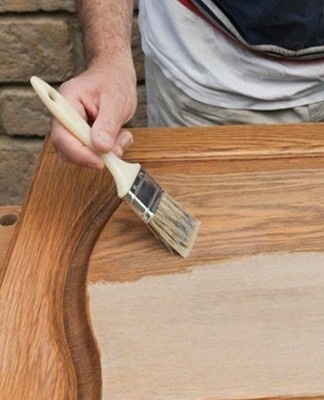
Nitrolac lacquer lasts longer on wooden decorations. Shellac creates an ideal shiny surface. The stain varnish will make the light wood a few shades darker. The wax protects the surface, adds shine and color. Special stains and transparent impregnations emphasize the wood structure or imitate expensive woods on wooden surfaces. The most durable is ship's varnish.
However, it cannot be used indoors and on furniture due to the content of toxic substances which continue to evaporate for many years after application.
Paints
The following compositions are suitable for painting old furniture:
- water-based acrylic - they pass air, preventing the appearance of fungus, do not smell;
- alkyd - moisture resistant, suitable for bathroom furniture;
- oil - the most durable.
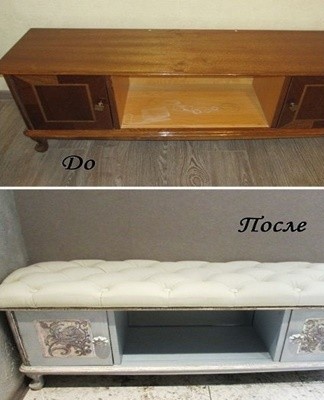
Metallic spray paints can be used to showcase jewelry.
When choosing white paint, you should pay attention to its shade. It comes in warm and cold tones. Red, orange and yellow pigments are added to warm tones, and blue and green to cool tones. You also need to consider the lighting, because in a dark and bright room the white tones look different. For example, a white with a magenta tint appears pink.
Step-by-step instructions for repainting
Work steps:
- wash the item with water and detergent;
- after drying, disassemble into separate elements, remove the handles, remove the boxes, unscrew the legs;
- process with fine-grained emery to smooth out the roughness and remove the old coating;
- cover large cracks with putty;
- tape the parts that do not need to be painted;
- cover with a primer;
- apply paint;
- after the first coat has dried, apply the second, then, if necessary, the third.
When the paint is completely dry, the furniture is varnished. Metal frames are also sanded, primed for metal, and then painted.
Opening
Apply 2-3 coats of varnish to the painted and cleaned surface. Each layer should dry for at least 40 minutes. For varnishing, brushes are used or a special pad is made - cotton wool is dipped in the composition and wrapped in linen. The coating is applied evenly, with blotting movements and in all directions.
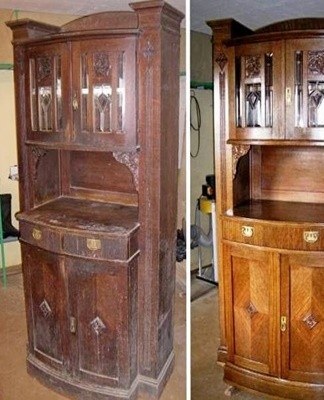
How to paint antiques
To artistically weather a freshly painted surface, you need candle wax and a knife.
How to create a vintage effect:
- clean the painted sides of the object from dust and sand;
- cover with a transparent primer;
- wax protruding parts, corners, edges;
- cover with paint;
- after drying, scrape the waxed areas with a knife;
- level the surface with emery.
Due to the wax, the paint does not adhere well to the surface and is easily removed, which can achieve the effect of the worn coating from time to time.
The second way to age wooden furniture:
- cover the cleaned surface with a thin layer of white paint;
- wait for the coating to dry halfway;
- Wipe with a dry cloth.
At the end, cover the product with transparent varnish.
White spots
Oak, pine, birch and maple lend themselves well to repainting in a light tone.
Coloring method:
- wipe the surface with a damp cloth to collect dust;
- first remove the old paint with coarse emery, then sand with fine grit;
- cover the carved decorations, moldings, slats with paint of a more saturated shade - light beige, pale blue;
- apply white paint in 2-3 coats over the whole article and the dried parts.
Tinted paint highlights the decor of the furniture, otherwise it merges with a solid surface.

Wooden furniture can be brightened with a bleaching paste. As a result, whitish traces characteristic of antiquity remain on the surface of the product. Porous species are suitable for bleaching - oak, ash. For work you need a wire brush.
How to lighten furniture:
- paint the surface, free of dust and old coating, with colored paint in one layer;
- after drying, make grooves with a wire brush along the wood fibers;
- apply the paste.
Clean the dried coating from paste residues with a dry cloth and fix the result with a finishing coat of varnish.
Features of coloring of different materials
Solid board and particle board are absorbent. The preparation of the surfaces to be painted also differs.
MDF
How to paint fiberboard furniture:
- clean and degrease the surface;
- sand with coarse emery;
- cover with an acrylic primer, carefully filling the cavities.
To get a smooth surface, you need several coats of paint.
chipboard
Compressed chipboards are painted in much the same way:
- clean the surface from dust, degrease;
- putty is applied;
- leveled with emery.
Paint is applied on top or a primer is also used.
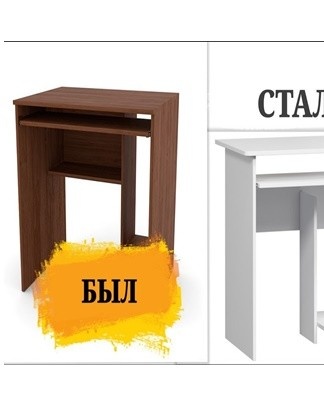
The peculiarity of chipboard is the initially uneven surface. To level it and reduce the consumption of paint, the boards must be puttyed.
natural wood
Wood fibers rise on contact with aqueous compounds. Therefore, after cleaning, the boards are coated with a primer, and after drying, they are sanded with fine-grain emery. Natural wood furniture does not need to be coated with thick paint. To preserve the texture, dyes and transparent dyes are used. With their help, cheap pine can look like expensive oak. Varnishing without paint will accentuate the beauty of the natural color of the wood.
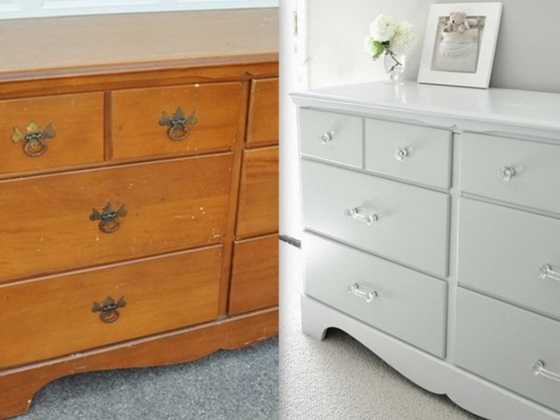
interesting ideas
Options for transforming old furniture:
- a dark wood chest of drawers with turquoise paint and new gold handles;
- the novelty is introduced by moldings painted with gold or silver paint;
- a simple chipboard dresser looks original in white with corners, legs and drawer edges painted in a contrasting shade. Chrome handles will add shine;
- the desktop is decorated with a geometric pattern or painted on boxes, gluing the bottom areas with masking tape;
- a dark wardrobe is illuminated with light colors. The outer edges of the valves are decorated with dark squares. The yellow color on the interior surfaces will add originality;
- the lacquered chipboard cabinet with door moldings is renewed with two contrasting paint colors. The space inside the moldings is painted in a light color and the rest of the surface, including the decor, is dark;
- To create a mosaic pattern, the front of the cabinet is painted one color, waxed, and painted another color. After drying, the surface is wiped with emery, and the lower layer of paint shines through the upper layer;
- to give the old chairs a modern look, they are covered with a printed fabric and painted in bright matte colors - yellow, light green, orange;
- to decorate a coffee table, the top is covered with white, gray or pastel paint, then a pattern is applied with a stencil with a contrasting color spray;
- chest of drawers, desks are painted in different colors, one or more drawers are distinguished by a bright tone, patterns;
- Sculpted monograms and embellishments are highlighted on furniture painted white with navy blue permanent marker and coated with clear varnish.
An unusual solution is to emphasize the moldings in white against the background of the general green color of the chest of drawers. With the help of stencils and paint in pots, patterns are applied to cabinet doors and countertops, and with the help of spray cans, color transitions and an ombré effect are created. To decorate bedside tables, stools and cabinets with patterns, a decorative film is also glued.

